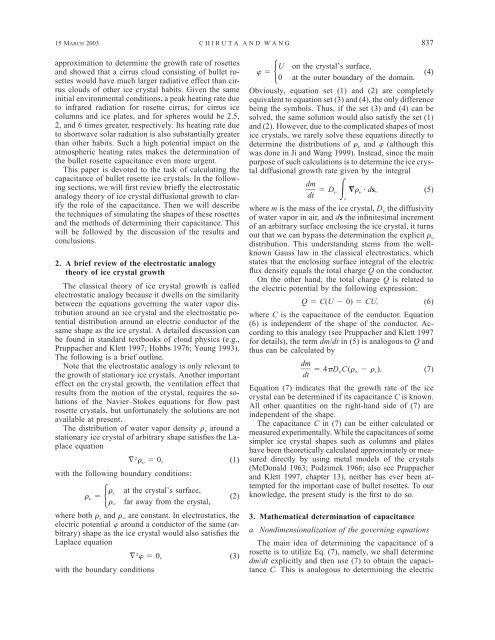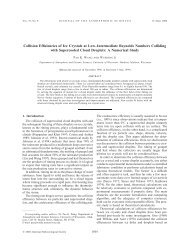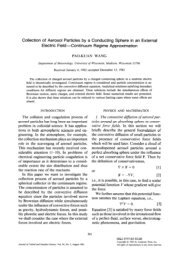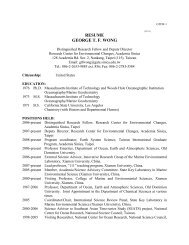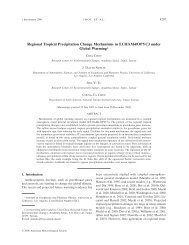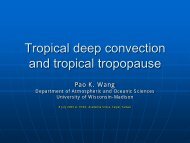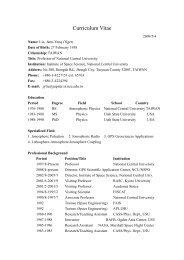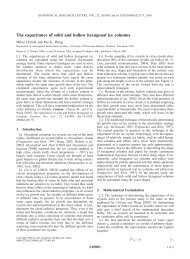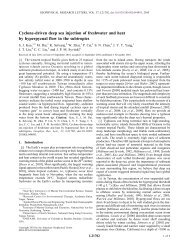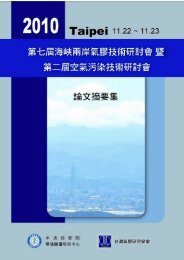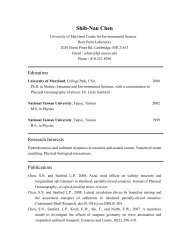The Capacitance of Rosette Ice Crystals - University of Wisconsin ...
The Capacitance of Rosette Ice Crystals - University of Wisconsin ...
The Capacitance of Rosette Ice Crystals - University of Wisconsin ...
You also want an ePaper? Increase the reach of your titles
YUMPU automatically turns print PDFs into web optimized ePapers that Google loves.
15 MARCH 2003 CHIRUTA AND WANG<br />
837<br />
approximation to determine the growth rate <strong>of</strong> rosettes<br />
and showed that a cirrus cloud consisting <strong>of</strong> bullet rosettes<br />
would have much larger radiative effect than cirrus<br />
clouds <strong>of</strong> other ice crystal habits. Given the same<br />
initial environmental conditions, a peak heating rate due<br />
to infrared radiation for rosette cirrus, for cirrus ice<br />
columns and ice plates, and for spheres would be 2.5,<br />
2, and 6 times greater, respectively. Its heating rate due<br />
to shortwave solar radiation is also substantially greater<br />
than other habits. Such a high potential impact on the<br />
atmospheric heating rates makes the determination <strong>of</strong><br />
the bullet rosette capacitance even more urgent.<br />
This paper is devoted to the task <strong>of</strong> calculating the<br />
capacitance <strong>of</strong> bullet rosette ice crystals. In the following<br />
sections, we will first review briefly the electrostatic<br />
analogy theory <strong>of</strong> ice crystal diffusional growth to clarify<br />
the role <strong>of</strong> the capacitance. <strong>The</strong>n we will describe<br />
the techniques <strong>of</strong> simulating the shapes <strong>of</strong> these rosettes<br />
and the methods <strong>of</strong> determining their capacitance. This<br />
will be followed by the discussion <strong>of</strong> the results and<br />
conclusions.<br />
2. A brief review <strong>of</strong> the electrostatic analogy<br />
theory <strong>of</strong> ice crystal growth<br />
<strong>The</strong> classical theory <strong>of</strong> ice crystal growth is called<br />
electrostatic analogy because it dwells on the similarity<br />
between the equations governing the water vapor distribution<br />
around an ice crystal and the electrostatic potential<br />
distribution around an electric conductor <strong>of</strong> the<br />
same shape as the ice crystal. A detailed discussion can<br />
be found in standard textbooks <strong>of</strong> cloud physics (e.g.,<br />
Pruppacher and Klett 1997; Hobbs 1976; Young 1993).<br />
<strong>The</strong> following is a brief outline.<br />
Note that the electrostatic analogy is only relevant to<br />
the growth <strong>of</strong> stationary ice crystals. Another important<br />
effect on the crystal growth, the ventilation effect that<br />
results from the motion <strong>of</strong> the crystal, requires the solutions<br />
<strong>of</strong> the Navier–Stokes equations for flow past<br />
rosette crystals, but unfortunately the solutions are not<br />
available at present.<br />
<strong>The</strong> distribution <strong>of</strong> water vapor density around a<br />
stationary ice crystal <strong>of</strong> arbitrary shape satisfies the Laplace<br />
equation<br />
2<br />
0,<br />
(1)<br />
with the following boundary conditions:<br />
s<br />
at the crystal’s surface,<br />
<br />
<br />
(2)<br />
far away from the crystal,<br />
<br />
where both s and are constant. In electrostatics, the<br />
electric potential around a conductor <strong>of</strong> the same (arbitrary)<br />
shape as the ice crystal would also satisfies the<br />
Laplace equation<br />
2<br />
0, (3)<br />
with the boundary conditions<br />
U on the crystal’s surface,<br />
<br />
<br />
(4)<br />
0 at the outer boundary <strong>of</strong> the domain.<br />
Obviously, equation set (1) and (2) are completely<br />
equivalent to equation set (3) and (4), the only difference<br />
being the symbols. Thus, if the set (3) and (4) can be<br />
solved, the same solution would also satisfy the set (1)<br />
and (2). However, due to the complicated shapes <strong>of</strong> most<br />
ice crystals, we rarely solve these equations directly to<br />
determine the distributions <strong>of</strong> and (although this<br />
was done in Ji and Wang 1999). Instead, since the main<br />
purpose <strong>of</strong> such calculations is to determine the ice crystal<br />
diffusional growth rate given by the integral<br />
dm D · ds, (5)<br />
dt<br />
s<br />
where m is the mass <strong>of</strong> the ice crystal, D the diffusivity<br />
<strong>of</strong> water vapor in air, and ds the infinitesimal increment<br />
<strong>of</strong> an arbitrary surface enclosing the ice crystal, it turns<br />
out that we can bypass the determination the explicit <br />
distribution. This understanding stems from the wellknown<br />
Gauss law in the classical electrostatics, which<br />
states that the enclosing surface integral <strong>of</strong> the electric<br />
flux density equals the total charge Q on the conductor.<br />
On the other hand, the total charge Q is related to<br />
the electric potential by the following expression:<br />
Q C(U 0) CU, (6)<br />
where C is the capacitance <strong>of</strong> the conductor. Equation<br />
(6) is independent <strong>of</strong> the shape <strong>of</strong> the conductor. According<br />
to this analogy (see Pruppacher and Klett 1997<br />
for details), the term dm/dt in (5) is analogous to Q and<br />
thus can be calculated by<br />
dm 4D C( s ). (7)<br />
dt<br />
Equation (7) indicates that the growth rate <strong>of</strong> the ice<br />
crystal can be determined if its capacitance C is known.<br />
All other quantities on the right-hand side <strong>of</strong> (7) are<br />
independent <strong>of</strong> the shape.<br />
<strong>The</strong> capacitance C in (7) can be either calculated or<br />
measured experimentally. While the capacitances <strong>of</strong> some<br />
simpler ice crystal shapes such as columns and plates<br />
have been theoretically calculated approximately or measured<br />
directly by using metal models <strong>of</strong> the crystals<br />
(McDonald 1963; Podzimek 1966; also see Pruppacher<br />
and Klett 1997, chapter 13), neither has ever been attempted<br />
for the important case <strong>of</strong> bullet rosettes. To our<br />
knowledge, the present study is the first to do so.<br />
3. Mathematical determination <strong>of</strong> capacitance<br />
a. Nondimensionalization <strong>of</strong> the governing equations<br />
<strong>The</strong> main idea <strong>of</strong> determining the capacitance <strong>of</strong> a<br />
rosette is to utilize Eq. (7), namely, we shall determine<br />
dm/dt explicitly and then use (7) to obtain the capacitance<br />
C. This is analogous to determining the electric


